|
 Stone Balls:
(Petrospheres).
Stone Balls:
(Petrospheres).
There are two kinds
of Petrospheres - Those fashioned by humans, and those formed by
nature.
There have been
several suggestions to attempt to explain why people were driven to
produce stone balls on such a large scale (as in the case of
Scotland and Costa Rica), ranging from symbols of wealth or status
to geometric aids or because of their serene, harmonic beauty, but
there are more than enough examples to show that stone itself was
given a form of reverence in prehistory, and was likely seen as
being endowed with 'special' qualities (as shown by the specific
selection and transport of stone at Megaliths). Certainly other
cultures appear to have become 'besotted' with stone carving such as
the Easter Islanders, Egyptians, Mayans, and perhaps that is all we
see with carved petrospheres.
(More
about Specific Stone Selection in Megaliths)
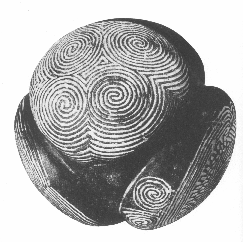 The Scottish
Stone Balls: The Scottish
Stone Balls:
The majority of the
balls were discovered in Aberdeenshire, an area also associated with
a high concentration of recumbent stone circles. Most of the stone
balls conform to a standard size and over half have six embossed
geometric knobs carved onto them, although some have as many as 160 dimples
engraved on them.
Over 400 of these small geometric carved stones
have been discovered in Scotland. Curiously, they appear to have
been made with an understanding of the 'platonic solids', as the
majority of them have been designed to conform with one of the five
geometric solids.
(More
about the Scottish Stone Balls)
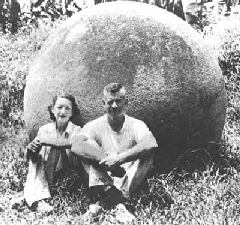 The
Giant Stone Balls of Costa Rica:
The
Giant Stone Balls of Costa Rica:
With over 300 of
the carved stone balls having so far been discovered, ranging in
size from a few centimetres to over 2 metres (6.6 ft) in
diameter, and weighing up to 16 short tons (15 t), Costa Rica
offers both the largest and the worlds richest supplies of
carved stone spheres, believed to have been carved between 200
BC and 1500 AD, their origin and purpose is still unknown.
|
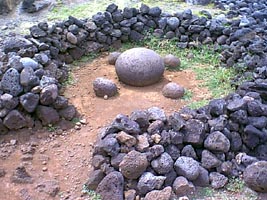 The
Navel of the Navel - Easter Island. The
Navel of the Navel - Easter Island.
There is a
carved stone sphere on Easter Isle at the northern coastal area
of the island, just north of the statue quarry at the volcanic
crater of Rano Raraku. The
site, "Te pito kura" was most likely a ritual centre for
the earliest islanders to pray and divine.
The islanders
have a legend that the statues were moved by the use of mana,
or mind power, and according to one legend, use was made of a
finely crafted stone sphere, 75 cm (2.5 ft) in diameter, called
te pito kura (�the golden navel� or �the navel of
light�), to focus the mana.
(More
about Easter Island)
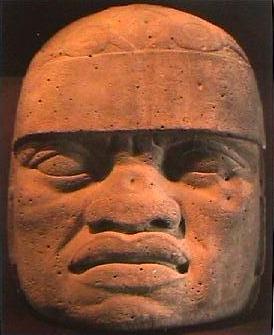 The
Giant Olmec Stone Heads: The
Giant Olmec Stone Heads:
Several of these large stone heads have been
found associated with ceremonial Olmec sites in the Mexican
Gulf. The basalt stone for these heads was transported from up
to 50 miles in some cases, and the Negroid features have led
some to suggest a pre-Columbian contact with Africa. There are
also petrospheres reported but it is unknown if they are natural
or carved.
|
Nature has
provided us with some incredible examples of petrospheres
(concretions), of which some of the best (the most spherical)
are shown in the following images.
Bosnia:
There have been several reporting's of Petrospheres from Bosnia,
a country which has been in the limelight recently following
claims of the discovery an ancient pyramid complex near Visoko
in Bosnia Hertzogovnia. Although this has fuelled the idea that
the Bosnian petrospheres are carved, all such claims have been
refuted by geologists.
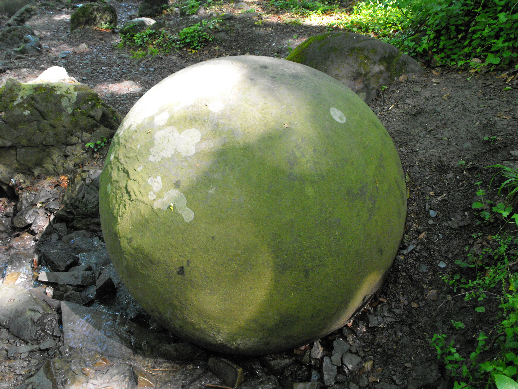
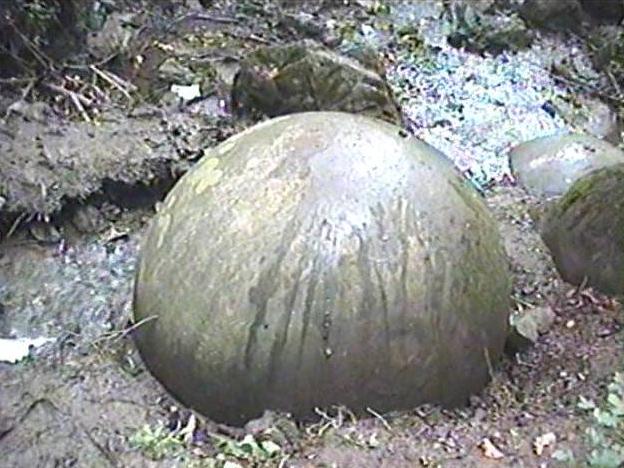
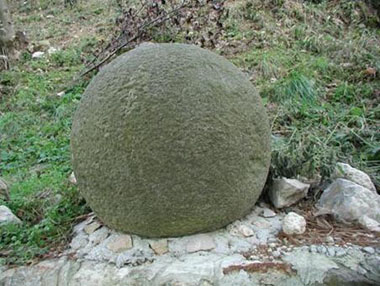
The largest site in
Bosnia known for stone balls is the County
Zavidovici, approx. 100 km
north of Sarajevo. It is the first place in Europe which has
established an �Archaeological Park of Stone Balls". This site
contains approx. 40 stone balls of enormous size, all of which are
recognised as natural 'concretions'.
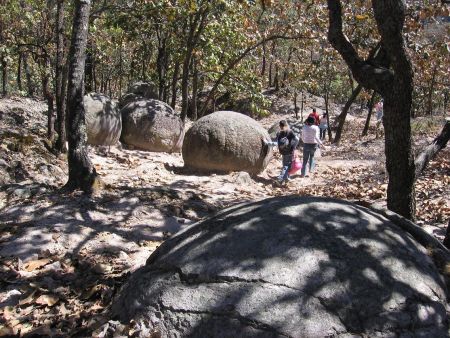
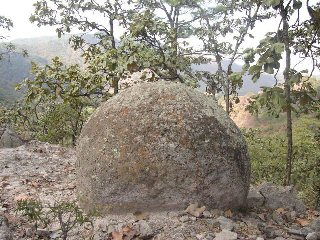
Natural
spherical concretions on the 'Cerro Piedras Bola' near Jalisco,
Mexico.
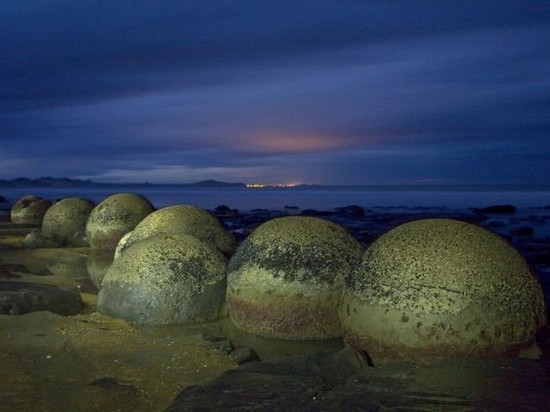
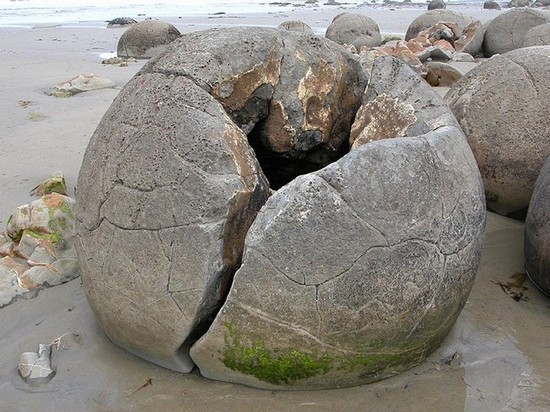
The Moeraki
Boulders on a New Zealand beach.
The Chinese
'Volcano Eggs'
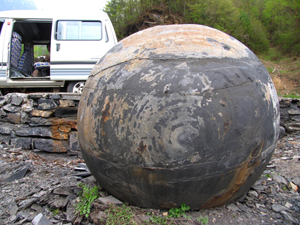
'A large number
of "Volcano eggs" were recently discovered along with a copper
sword at a construction site in Bandeng Hill and Zhanlong Hill,
Gongxi Town of Hunan Province. The discoveries were made by
highway construction workers while they were digging the
foundation for a road. geologists believe that the stone eggs
are rare, large concretions of the carbonate rock'.
(1)
'The
construction workers said that Bandeng Hill is quite simply a
stone-egg mountain. They found multiple nests of unique stone
eggs throughout the course of digging the road's foundation. The
eggs are oval in shape, with a wide range of sizes; the smallest
one being no bigger than a water melon, while the largest is
reported as being the size of a big table. Upon closer
examination they look like eggs from the outside, but are very
shiny and black on the inside'.
(Carved
Olmec Stone Heads)
(Scottish
Stone Balls)
(Costa Rica
Petrospheres)
(Extreme
Masonry) (Anomalous
Artefacts Homepage)
(Pre-Columbian
America's Homepage) |